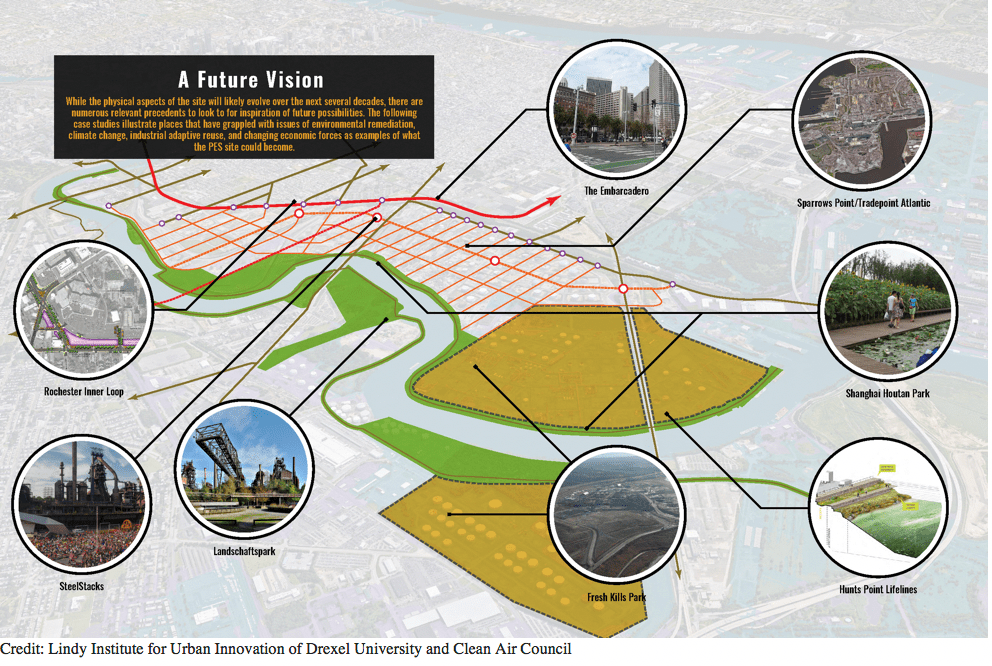Visioning the Future of the PES Refinery Complex

- Drexel Environmental Collaboratory Releases Cross-Sector Findings on Severe Weather Recovery Challenges
- Drexel History 103: How Well Do You Know Drexel University’s Presidents?
- Drexel’s Hydration Stations Cut Plastic Waste and Costs
- Drexel Launches the Manuel Stamatakis Center for Alternative Investments at the LeBow College of Business

Drexel University’s Lindy Institute for Urban Innovation and Clean Air Council today released “Visioning the Future of the Philadelphia Energy Solutions Refinery Complex,” a report about the potential long-term future of the former 1,400-acre Philadelphia Energy Solutions (PES) oil refinery site on the Lower Schuylkill. The report was designed to spark a conversation about how to ensure the long-term development of the site allows connectivity to the rest of the city and yields equitable economic and environmental benefits to the city and its residents. The report was created through a community visioning process funded by a grant from the William Penn Foundation.
The 1,400 acre PES refinery site on Philadelphia’s Lower Schuylkill River was purchased by Hilco Redevelopment Partners earlier this year after a fire and explosion in the summer of 2019 caused PES to declare bankruptcy. South and Southwest Philadelphia residents and groups have called for a cleaner future use of the site that would advance environmental justice.
“With the permanent end to the city’s largest industrial source of harmful air pollutants and climate pollution,” Philadelphia has a once in a generation opportunity to rethink the long-term future of this important site to ensure it protects our environment, health, and safety while spurring economic development and high-paying union jobs," said Joseph Otis Minott, executive director and chief council of Clean Air Council.
Hilco’s redevelopment plans call for a new logistics warehousing hub to be built on the site, though few specifics have been released publicly.
“The former PES refinery on the Lower Schuylkill represents the single most important development site in the city,” said Harris Steinberg, executive director of the Lindy Institute for Urban Innovation at Drexel University. “Its strategic location between the job-rich hubs of Center City, University City, Philadelphia International Airport and the Philadelphia Navy Yard gives us the opportunity to create the template for an equitable, just and inclusive Philadelphia. Our goal is to jump start a robust public conversation about how Philadelphia can best integrate the site into the city over the next century”
This vision for the Lower Schuylkill calls for a series of key moves by the city in partnership with Hilco.
- Extend the Schuylkill River Trail through the site to the mouth of the Schuylkill River at Girard Point. Implement, at the minimum, the city’s required 50-foot setback from the river’s edge for public waterfront access.
- Create a street grid and central boulevard across the site to integrate the site into the surrounding city. Over time, the grid can be broken down in scale to allow the site to evolve from logistics and light industrial to one that supports a greater diversity of uses including commercial, institutional, civic, and possibly even residential. Ultimately, a signature gateway bridge would be built at Girard Point as a southern gateway to Philadelphia from the airport.
- Turn the Schuylkill Expressway at Point Breeze into a surface boulevard that eliminates this barrier between the neighborhood and the site and extend Point Breeze Avenue to the river.
- Create new green and open spaces for the adjoining neighborhoods and the city’s park system. Develop green infrastructure on the portions of the site that are in the floodplain.
- Expand public transit connectivity through new hubs of activity (for example, mixed-use centers, park space, or other employment hubs) across the site.

The former refinery’s development follows on the heels of the recent Central Delaware River Waterfront decision – a massive planning process that began 14-years ago ad was largely driven by public input. The decision represents an estimated $2.2 billion investment for the central Delaware waterfront and overtook a Sixers arena proposal. This successful public planning process for the Central Delaware Riverfront over the past decade-and-a-half – one that engaged more than 6,000-Philadelphians – could provide a template for how the city can create a framework for long-term growth on privately held land which advances both public benefit and development potential.
The vision for the Lower Schuylkill rests on the principles of social and environmental justice; climate adaptation; and inclusive growth and prosperity. It calls upon Hilco and the City to engage the larger public in an open planning process that ensures that this site is an accessible and productive centerpiece of a 21st century Philadelphia by integrating the site into the surrounding city.
Drexel News is produced by
University Marketing and Communications.